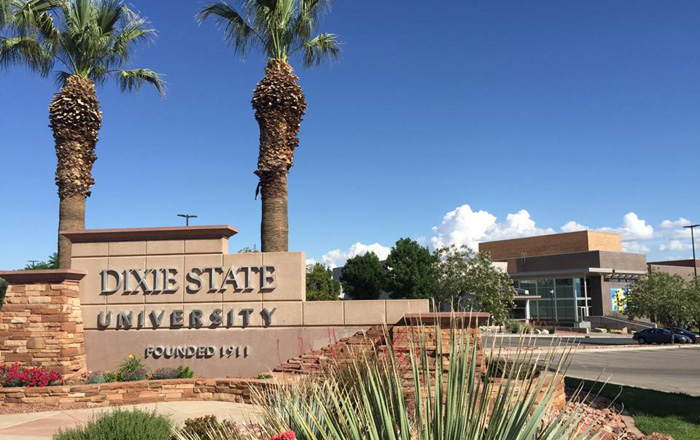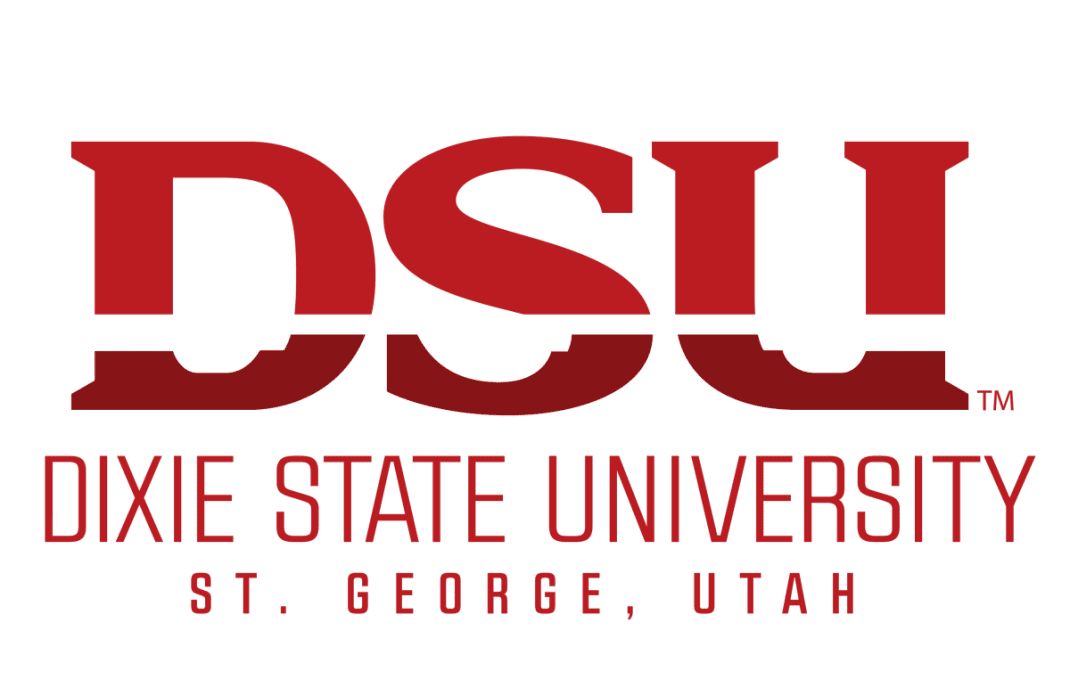Dixie State University has seen several changes in the past decade. In 2009, when the institution was still Dixie State College, the athletic teams’ name changed from the Rebels—the name held since 1952—to the Red Storm. In January of 2013, the college underwent a name and status change from Dixie State College to Dixie State University. Now Dixie State University is once again attempting to rebrand its identity by revisiting the choice of the institutional nickname and mascot. However, regardless of the recent controversy surrounding the name of “Dixie,” changing that part of the university’s identity is not one of the considerations on the table.
“We are really excited about the future of Dixie State University and are diligently working on all the goals and strategies outlined in our strategic plan, Dixie 2020: Status to Stature,” said Jyl Hall, Director of Public Relations and Marketing. “We are confident a new institutional nickname and athletic mascot will get the entire community as excited as we are for the future of DSU. It is important that each and every person in the community feels ownership of the university and knows that Dixie is their university and is proud of our offerings and accomplishments. Our goal is that a new identity will encourage community members to be even more engaged in campus happenings.”
In an effort to establish a strong brand and identity for the university, the president of DSU, Dr. Richard “Biff” Williams, has commissioned an “identity committee” to oversee the process of changing the institution’s nickname and athletic mascot from Red Storm and Big “D” the Bull, respectively.
“A strong identity allows an organization to more effectively tell its story. Dixie State University has a rich history, an incredibly bright future and an amazing story to tell, and it deserves an identity that will articulate its unique message.” said Dr. Jordon Sharp, director of student involvement and leadership at DSU and a member of the Identity Committee. “The research overwhelmingly demonstrates that the current identity is confusing and a more authentic brand is not only desired, but much needed,” Dr. Sharp said.
The committee—made up of individuals representing DSU alumni, students, athletics department, faculty, staff, administration and community—is working with a Utah-based company called Love Communications to create the new nickname and mascot. Love Communications was chosen based on their experience within higher education, athletics and similar rebranding campaigns. An estimated $50,000 dollars will be paid to the company for the rebranding process. The research will be done in three phases.
Love initially will study the extensive research that has already been conducted in the last 10 years and measure the opinions regarding the university’s identity. Students, faculty, staff, alumni and community member have all had input in the past. That information will be analyzed in the first phase of the process. Love will also review the transcripts of interviews and community members. Additionally, they will look at the Strategic Planning Committee data collected during a yearlong process in identifying DSU’s mission, values, goals and strategies.
The second phase of the rebranding process will be to create multiple concepts for the university’s new identity based on new research and investigations. DSU’s Identity Committee will choose three finalists from the final concepts created from the research. The agency will then develop and design mascot renderings, logo’s, color schemes, and overall brand concepts for all of the three options. The ideas and renderings will then be presented to major DSU stakeholders and measure interest among them.
For the final step and to complete the process, the Identity Committee and Love Communications will roll out and implement the new identity and mascot. It is planned to be a community celebration.
The committee and all involved are working to complete the first two phases by the end of December 2015. The goal is to implement phase three in early 2016.
“The Board of Trustees of Dixie State University can be assured that the new identity will take into consideration our past, the new strategic plan, the research that has been gathered for more than a decade, and the elements of an effective brand along with the guidance of branding professionals,” Dr. Sharp said. “Although mascots, nicknames, and colors are subjective, I believe we will discover an identity that is clear, authentic, and distinct, and that successfully tells the great story of Dixie State University.”
At this point, no one has mentioned changing the name of the university itself. The most recent controversy has dealt with the associations with the name “Dixie.” However, the issue of a name change also came up when the college signed an agreement with the University of Utah in 2007 to become affiliated with them. The University of Utah wanted the name changed to University of Utah, St. George. Concerns were raised that beyond just the name change, at stake was also losing local power to the Salt Lake-based university. Some large financial backers threatened to pull their support if the name changed, and ultimately the agreement with the University of Utah failed.
In January of 2013, while under the direction of President Stephen D. Nadauld, the school’s board of trustees voted unanimously to change the school’s name to Dixie State University from Dixie State College when state education officials, the Utah Legislature and the governor gave their approval to the college’s bid to become a university.
The trustees at that time chose the name Dixie State University from four options presented by marketing agency Sorenson Advertising after organizing a series of college and community forums to determine the public’s preferences. Three of the options included the word “Dixie,” even though some people expressed concerns that the name may brand the school as an institution with ties to America’s pre-civil rights issue and the Confederate states that fought to uphold slavery during the Civil War.
The name of the school created an impassioned debate after launching a rebranding process back in 2013. A bronze statue of two Confederate soldiers, “The Rebels,” was removed from the Dixie State campus and returned to its creator, local artist Jerry Anderson, in exchange for Anderson’s donation of other artwork for permanent display on campus. At issue was Anderson’s statue depicting a Confederate soldier on horseback helping an injured comrade with a Confederate flag in hand.
DSU graduate and Independent contributor Marcos Camargo, who did extensive research on the topic with former Dixie College president and professor emeritus Dr. Douglas Alder, said that the college didn’t always have connections to the Confederate South.
“That began in 1951 when the college split from Dixie High School,” Camargo said. “The high school kept the old mascot (The Fliers) and the “Rebels” became the new mascot (apparently first suggested by a student). I’ve done some searching to see if I could find who the Rebel idea came from in hopes that I may be able to track down the motives behind its origin. I’ve never been able to do so. However, I did find a short pro/con debate published in the school paper in 1951 and discovered that the woman (a student at the time) who wrote the piece argued against changing the mascot to the Rebels.”
The word, southern Utah’s “Dixie” originally came from the pioneer era. Mormon pioneers arrived in the Salt Lake Valley in 1847. It wasn’t long before Mormon leader Brigham Young sent a group of those pioneers to the southern most area in the territory to grow cotton. A cotton mill was built in Washington City, which still stands today. Thus, the phrase, “Utah’s Dixie” was born. The name was chosen due to the fact that the area was located in the southern end of the territory, soon to achieve Utah statehood. The name of the mascot and athletic teams, at that time, was to become the “Dixie Rebels”.
Enrollment is always a concern for colleges and universities around the country, and some have claimed that the use of the name “Dixie” is actually a deterrent to some potential students, especially those of different ethnic backgrounds than Caucasian. The average enrollment increase over last year at Utah’s public colleges and universities has been reported at 2 percent. Dixie State University in St. George showed a slight decrease in enrollment with a student enrollment of -0.78 percent.






The students who attend DSU are “DEMONS.” They have always been “DEMONS” THE DIXIE DEMONS.
They have never really been Rebels, or Red Raiders, or Big “D.” They are “DEMONS.”
DIXIE STATE DEMONS
Closed Universities can again reopen with one solution,